The Ultimate Guide To Employee Rewards and Recognition
In the last two decades, rewards and recognition have been the driving force behind global companies’ success in delivering a near-perfect employee experience.
In a nutshell, rewards and recognition signify the appropriate acknowledgment, appreciation, and prompt incentivization of an employees’ effort.
It’s a time of war over talents out there.
To acquire and retain the top performers, you must build a workplace culture where employee recognition is the everyday norm.
According to Cicero, 69% of employees would work harder if they felt that their efforts were better appreciated.
As companies struggle to find a way to deal with the global economic slowdown, the simple act of recognizing an employee in a meaningful and memorable way is the missing link that can heighten the productivity levels, lower employee turnover, and create a sense of belonging.
- Chapter 1: Evolving Role Of HR
- Chapter 2: Difference Between Rewards And Recognition
- Chapter 3: Benefits of Rewards and Recognition
- Chapter 4: Rewards and Recognition Statistics
- Chapter 5: Technology In Rewards And Recognition
- Chapter 6: Building A Culture Of Peer To Peer Recognition
- Chapter 7: How To Select A Rewards and Recognition Platform?
- Chapter 8: How To Build A Successful Employee Rewards and Recognition Program?
- Chapter 9: Rewards And Gifting Ideas
- Chapter 10: Employee Recognition Ideas
- Summary
Chapter 1
Evolving Role of HR

Workplaces are going through a dynamic transformation. And with the changing scenario, HR functions are also evolving massively.
The main agenda is to devise a more employee-centric work environment where every employee's needs are considered noteworthy.
Employee recognition is not a mere task that managers tick off from their to-do-list. On the contrary, offering timely rewards and recognition should become a natural part of the company culture.
When employees feel appreciated for their contribution and work, it inspires a sense of loyalty towards the company.
Not surprisingly, the current dominating forces consisting of millennials and Gen Zs are tough to please.
They don’t see recognition as a memorable affair. Today’s advanced workforce feels designated to receive credit for doing a great job.
Giving recognition in a manner that would appeal to them is necessary to attract, retain, and satisfy the new wave of workers.
Top Challenges Harming Your Rewards And Recognition Efforts
- Lack of digitalization by manually rewarding and recognizing people.
- A generic rewards program that doesn’t suit your organization’s needs.
- Rewards and recognition are not awarded in a frequent and timely fashion.
- Appreciation is limited to a particular section of the workforce.
- Dismissing the need for a proper reward and recognition platform.
- Measurement of the ROI of routine employee appreciation.
Chapter 2
Difference Between Rewards And Recognition
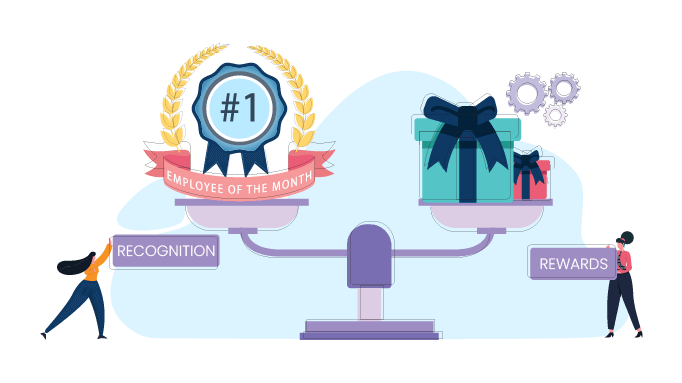
There is more hunger for love and appreciation in this world than for bread
~Mother Teresa
While you will find “rewards” and “recognition” being used interchangeably with each other, it is anything but the same.
To utilize both efficiently, we must know how they differ from each other.
| Rewards | Recognition |
|---|---|
| Rewards are tangible. Rewards are mostly monetary or have some monetary value that can be attached to it. | Recognition is intangible. Even though its value is not measurable, it remains an integral part. |
| Rewards are transactional in nature. For a particular input, you get an output in return. Thus, rewards are an excellent way to attract top talent to your organization. | Recognition is relational in nature. It’s a form of building an emotional connection between the employees and the organization. That makes recognition the ideal way to retain the said top talents. |
| Rewards are economical, considering that you get a much higher return in terms of productivity and, ultimately, business profits for investing in such small amounts of resources. | Recognition is emotional, a psychological event of feeling seen, appreciated, and mattered. Proper recognition has the power to motivate even the most dormant of employees. |
Chapter 3
Benefits of Rewards and Recognition

If you don’t create a great, rewarding place for people to work, they won’t do great work.
~Ari Weinzweig
Before we go ahead with the hows and whys of promoting an appreciative culture at work, let's look back at the seven most distinctive benefits of rewards and recognition in business:
Benefit 1: Company Culture
Frequent and timely recognition profoundly impacts the culture of the company.
A company’s culture is the combination of a company’s vision, goals, and ideologies for achieving the greater good.
An appreciation-based work culture builds trust and respect among the members of the workforce. Employees get a means to learn and praise their peers’ strengths and unique qualities.
Benefit 2: Competitive Edge
Rewards and recognition promote healthy competition among employees.
Implementing a culture of recognition in a structured and meaningful manner assures the employees that their hard work and efforts will not go unnoticed.
Employees try to bring their A-Game to work, and it is always beneficial for the company.
It helps the company achieve its goals faster and aids in employees’ personal and professional development.
Benefit 3: Improves Manager-Employee Relationships
People don’t leave jobs; they leave managers.
A big part of employee experience is dependent on the relationship that employees share with the managers.
Rewards programs give managers a way to connect with the employees and convey their regards. It helps both parties to bridge the gap between them.
Benefit 4: Boosts Team Spirit
Team recognition and rewards can play a vital role in increasing morale and promoting team building.
When recognition (mostly peer-to-peer recognition) becomes a norm in the company, it builds camaraderie and heightens team spirit.
Benefit 5: Empowers Employees
An exciting benefit of recognition is that recognition sparks empowerment among employees.
Recognizing employees inspires them to take autonomy and ownership in their work. They take pride in their job and their contribution to the success of the company.
By praising and recognizing efforts regularly, you encourage their efforts and enable them to develop.
Benefit 6: Employee Retention
Managing high employee turnover is the biggest challenge of human resource departments worldwide.
Although many factors lead to an employee’s decision to leave a company, employee satisfaction is a crucial one.
Employee satisfaction is mainly dependent on how the workforce’s treatment inside of the organization.
When you make it a point to recognize your employees duly, they get emotionally invested in the job and the company as a whole. They naturally tend to stay longer.
Recommended Article: Employee Satisfaction Survey
Benefit 7: Employer Branding
Good employer branding attracts the right candidate and promotes positivity along with employee engagement.
Recognition helps in building a strong brand identity. Recognition fuels good relationships and helps to create a lively atmosphere at work. It helps to promote employee advocacy subsequently.
When employees feel appreciated in the workplace, they become active advocates for the company and its products.
Recommended Article: A Definitive Guide To Employee Engagement
Chapter 4
Rewards and Recognition Statistics

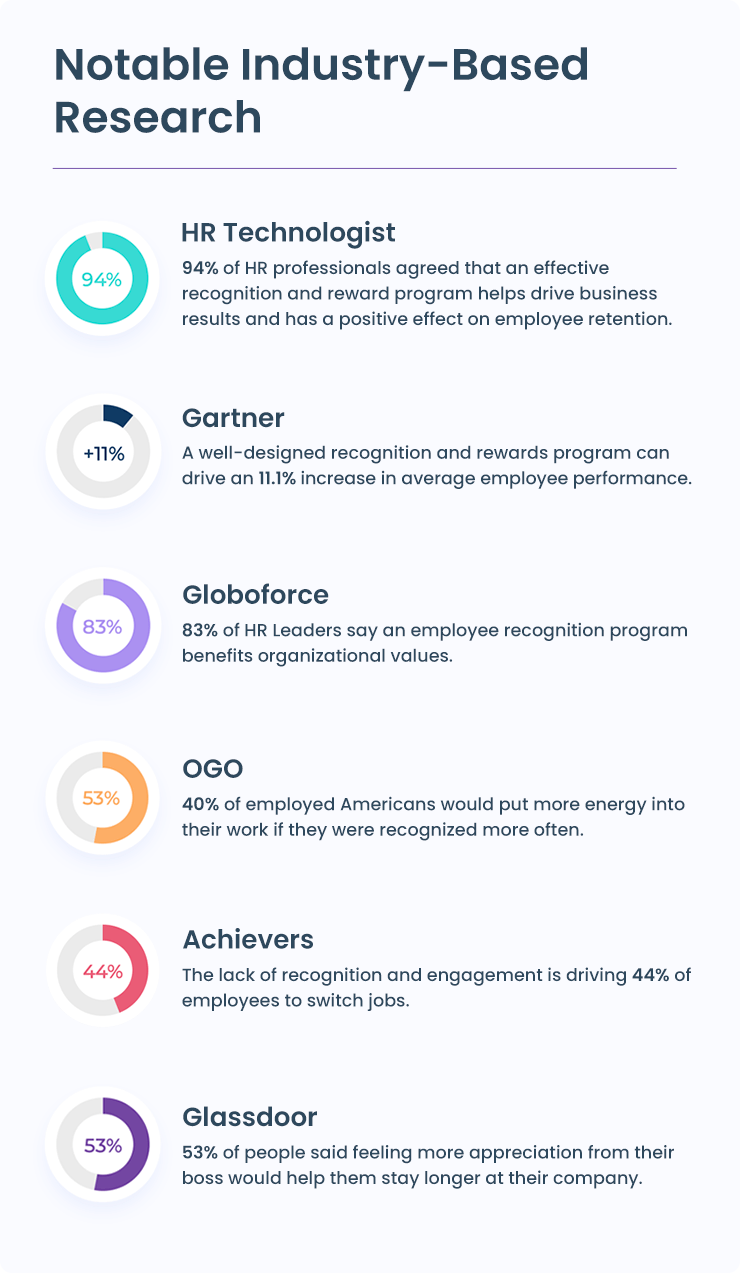
(Sources: HR Technologist, Gartner, Globoforce, OGO, Achievers, Glassdoor)
Chapter 5
Technology In Rewards And Recognition

Take time to appreciate employees, and they will reciprocate in a thousand ways.
~Dr. Bob Nelson
When it comes to getting recognition in the workplace, employees of today seek fast and instant recognition.
That presents a problem for companies with a large employee base where it’s less feasible for the leader to go up to each employee and congratulate them on their day-to-day achievements.
Constructive use of technology has made it easier to reward and recognize their workforce in an easier, faster, and more timely manner, making the whole process smoother to operate.
That’s where having a rewards and recognition platform integrated within your company comes into the picture.
Here’s how having a dedicated R&R platform is making the act of recognizing your workforce easier:
Instant Recognition

Recognition delayed is recognition denied. The modern workplace environment is fast, frantic, and changing constantly.
Implementing a digital rewards solution provides an environment where employees can be appreciated for the high quality of their work potentially within moments of completing it, rather than having a note left on their desk a month after completing a project saying, “good job.”
Data-Driven Insights
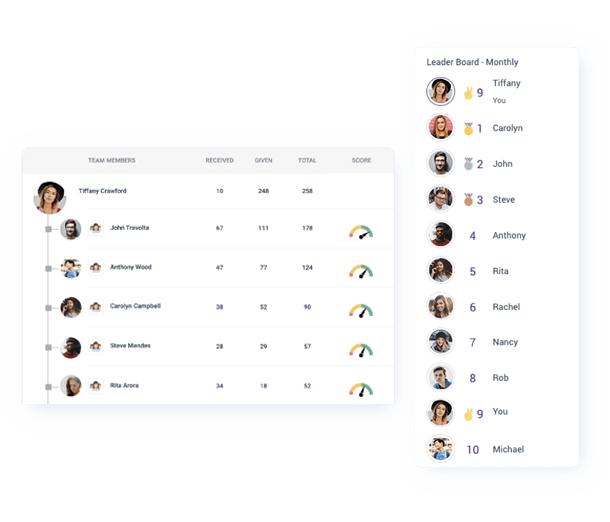
As data becomes more and more critical, an R&R platform allows you to get insights into how recognition invariably influences employee performance.
The right data helps you identify the most significant contributors in your teams, making it easier for you to recognize them.
It will also help you identify the areas in which it particularly works and the areas that don’t seem to do much to increase overall engagement.
Additionally, data-driven insights can help you identify gaps in the recognition giving pattern in your organization.
Panel Awards
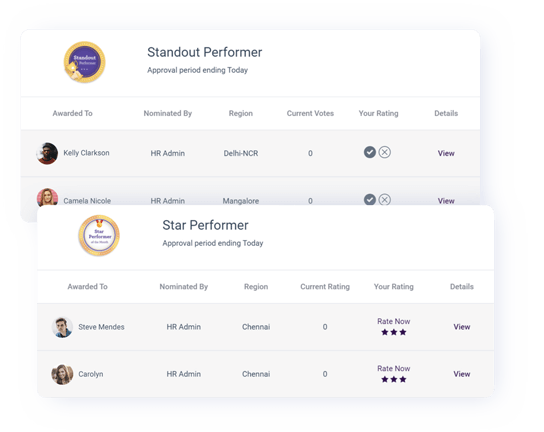
Not all organizations are created equal.
Each one differs in terms of various factors such as the number of employees and leadership roles, which means that recognition has to be flexible to accommodate the multiple parameters.
Panel award is a multi-level approver award system implemented in the Vantage Rewards platform. The award runs for the period of specified time during which the panel of selected approvers can vote for the nominated employees.
After the winner is collectively selected, the reward announcement instantaneously appears in the Vantage Rewards' social feed.
The Panel Awards ensures that rewarding an employee is a process where managers and leaders can proactively participate in. Additionally, it provides that employees get a fair and equal chance to win.
Deeper Engagement
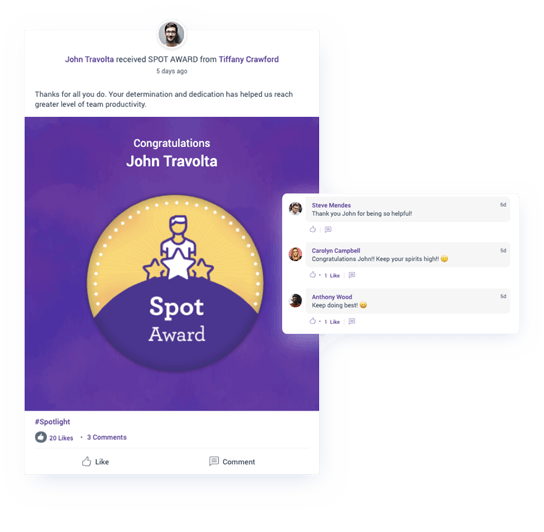
Sometimes, the effort to complete a task is more important than the job itself.
Rewards and recognition shouldn’t get limited to only the individual top performers. It must involve all employees across the company to build a sense of belonging and increase the motivation to do better.
A dedicated R&R platform helps make everyday tasks such as fixing an error or being on time an easily recognizable task.
Integrations
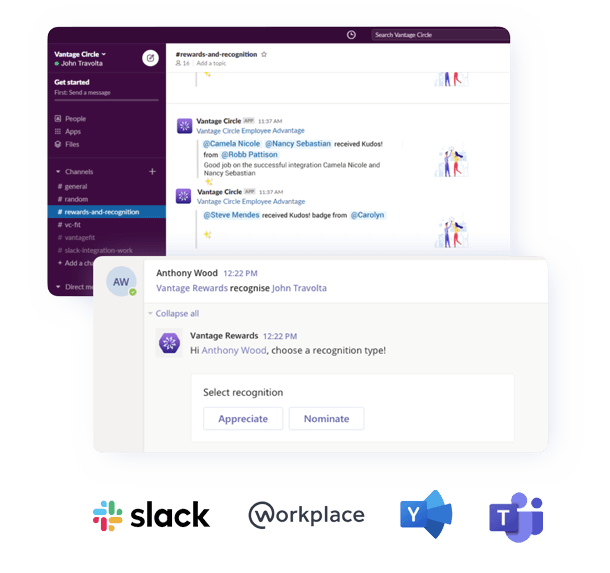
The ability of modern rewards and recognition systems, such as Vantage Rewards, to easily integrate with team collaboration tools such as Slack, Microsoft Teams, etc. has made it incredibly convenient for peers to appreciate each other on the go.
Appreciating a team member while working on a remote project can be as easy as doing it in the collaborative app. It ensures that peer recognition is not only encouraged but also practiced by the workforce.
Similarly, ensure that your chosen rewards and recognition platform is easily integrated easily with your HRMS system and allows for easy onboarding.
Greater Global Reach
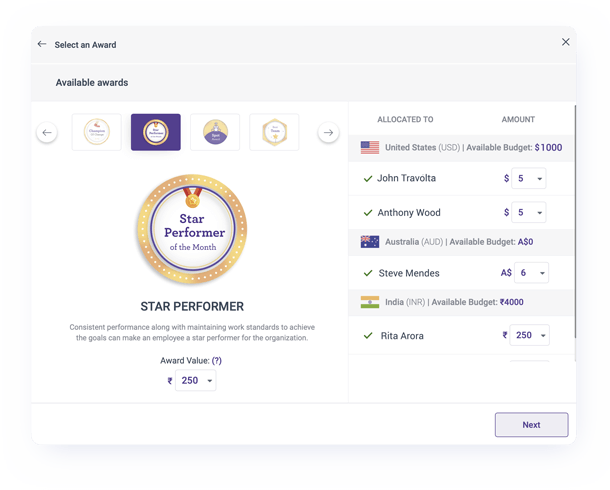
Traditional methods made it difficult to instill the company values in a consistent and continuous way to the entire workforce. That stands particularly true for businesses that include branches in multiple countries across the globe.
The use of technology has resulted in a faster and more efficient way to recognize employees, thus making rewarding employees on the spot a reality.
Some rewards and recognition platforms, such as Vantage Rewards, give organizations the possibility of rewarding their employees based in other countries through the SOLI framework. That ensures that global employees can earn or redeem reward points that match their achievements.
Thus, it turns awarding global employees into a more straightforward task and communicates the value placed by the organization on their entire workforce.
Recognition On The Go
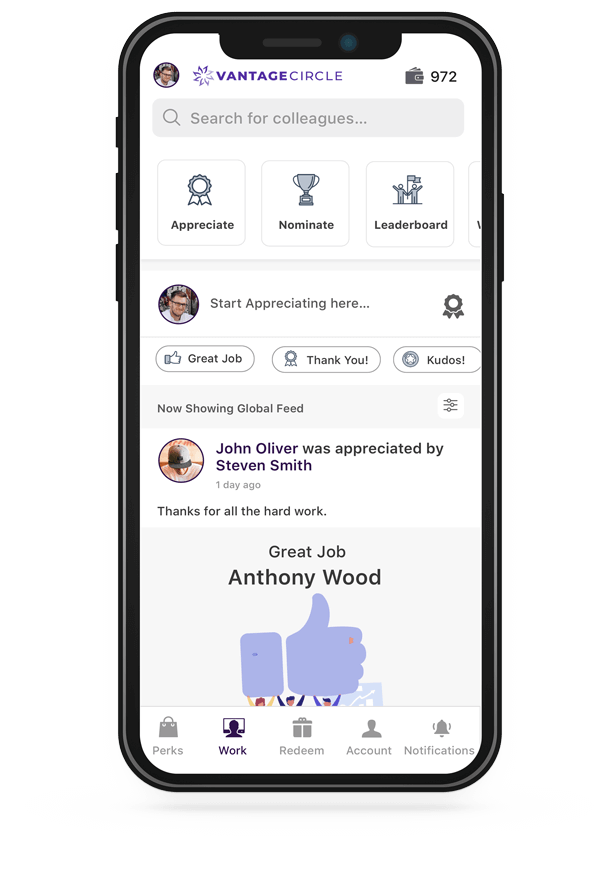
Today’s workforces are not only depending on their computers to stay connected. Mobiles, tablets, Kindles have steadily taken over the humble laptops and desktops.
The main driver for the above change is the need for accessibility. Similarly, a rewards and recognition program’s success depends mostly on whether it is available for multiple platforms (i.e., mobile apps) and multiple devices (Android, iOS, etc.).
Easier Budgeting
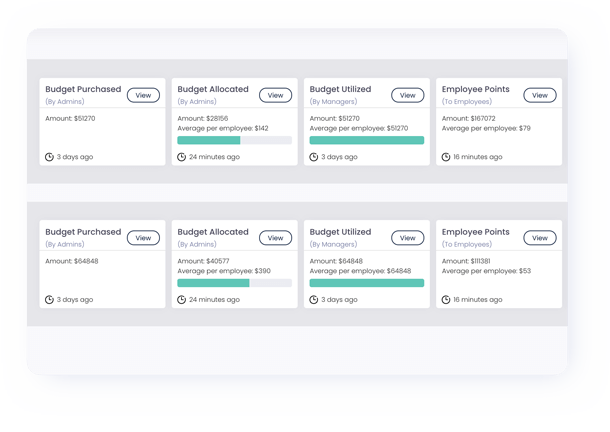
An in-house or manually run rewards and recognition program brings a whole plethora of challenges alongside with.
The time required for running the program. The handling of the additional paperwork. The issue of distributing rewards to a global and diverse workforce.
These “hidden costs” make a manually run R&r program more expensive than it looks like at an initial glance. Consequently, companies write such engagement measures as failures or unfeasible and never attempt such a thing again.
The solution? Any good rewards and recognition platform, such as Vantage Rewards, will help mitigate the problems mentioned above and present you with an easy budget allocation that conforms to your organizational needs.
The best part? The only problem you have to worry about while taking advantage of an external reward and recognition platform is choosing which employees you want to recognize.
Service Yearbook
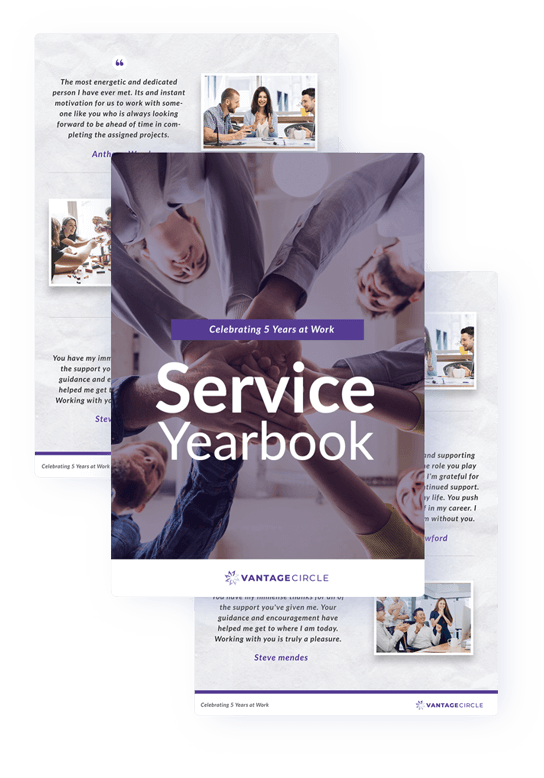
Peer appreciation is an incredible motivator for anyone, including your employees. A little but handy feature called Service Yearbook will prove to be the perfect recognition idea to facilitate and encourage peer-to-peer recognition in your organization indeed.
So, what exactly is the Service Yearbook? Think work anniversaries but an amplified yet secret version.
The Service Yearbook is a Vantage Rewards feature that allows peers to collect and share memories before someone’s work anniversary in a personalized online yearbook format.
This “secret gift” is only revealed during the work anniversary itself, where the person can see the significance of the role they played over the years of service.
Chapter 6
Building A Culture Of Peer To Peer Recognition
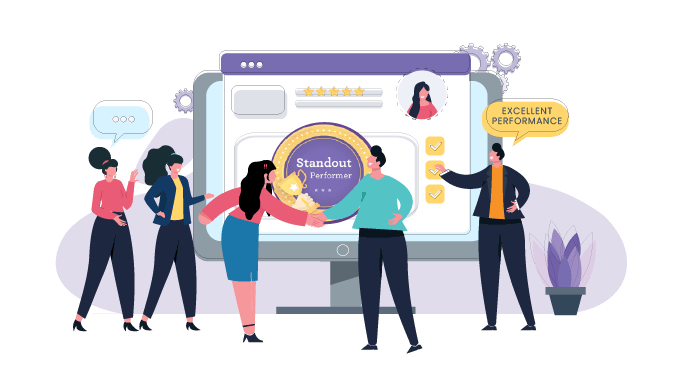
Brains, like hearts, go where they are appreciated.
~Robert McNamara
In today’s high performing and diverse workforce, employees seek and want to get recognized by their workplace peers.
A peer recognition program opens up an excellent opportunity to create a company culture of increased communication. All in all, it helps a company to place value on every person’s opinion.
- A successful peer recognition program can be beneficial in various ways:
- Boost in work relationships.
- Promotes the overall team spirit.
- Improves confidence and self-esteem.
Implementing Peer Recognition In Your Organization
Here is how you can simplify peer recognition to work for your organization instead of the other way around:
-
Firstly, to run a successful peer recognition program, you need to choose the right platform. A platform serves as an essential base where the employees can get access to their company network. That helps to notify other employees when one of their peers gets rewarded or recognized. Furthermore, other peers can engage by further congratulating and recognizing the recipient.
-
Have a company-wide solution that is more than just an HR initiative. When recognition is seen as a work culture norm, and not just another corporate feel good, you get more support from and more impact from your investment, allowing you to construct a pleasant employee experience.
-
Allow everyone the opportunity to give and receive recognition. Ensure that every employee is aware of your peer-to-peer recognition program and that each employee is welcome to use it to give recognition to their peers.
-
Make sure your peer-to-peer recognition program is easy to use and has both mobile and offline access. Make it easier for employees to recognize on the go, 24/7. Secondly, account for your remote workers and make sure that they have the tools and access required to be recognized.
Recommended Article: Improve Workplace Communication
-
Public recognition. Whether it’s a social media post or a “wall of fame” feature on your recognition program, highlighting achievements on monitors throughout the office and calling out successes, let others in your organization see the stellar performance that the employees are putting up.
-
Allow peers to participate in employee achievements. Whether you are congratulating a significant accomplishment or celebrating a work anniversary, invite peers to gather, comment, and be part of the presentation. In best in class companies, employees take the initiative to plan a peer’s recognition moment.
-
Leaders should continuously remind their workforce about the significance of recognizing great work. Try to keep it fresh and as a top priority. Remind employees to appreciate their peers frequently. Set the example for your employees for what to recognize and how to show appreciation.
-
Give continuous feedback to team leaders based on data to take corrective measures in recognizing employees better. Also, share the best practices that’ll make recognizing more impactful and benefit the team in the long run.
Chapter 7
How To Select A Rewards and Recognition Platform?

To win in the marketplace, you must first win in the workplace.
~Doug Conant
1. Make Sure the Program Suits your Organization
Digitization and technology have become a quintessential part of managing people.
The chances are that your organization is already using an HRMS for various HR functions.
It is essential to ensure that the employee recognition program can be seamlessly integrated into the existing HRMS.
You might also want to look out if you can white label the program to give it a company identity.
Recommended Article: Best HRMS Softwares
2. Resonate Company Core Values
A company’s recognition program must suit the company culturally. Recognition programs can be a great way to express your company’s core values.
So before choosing an employee recognition program, you must ensure that you can customize your program to fit your company requirements.
3. Cost
One of the preliminary things you should take care of before going for an R&R program is planning the budget. The budget for a large enterprise will be more than a medium-sized enterprise, which will be higher than a small-sized enterprise.
It is advisable to organize your expenses internally before selecting the right program.
SHRM recommends that HR departments spend at least 1% of payroll on rewards and recognition.
You might want to choose a program that gives you freedom towards budget allocation and assigning how you wish to use the budget.
While choosing a solution provider, look for hidden costs involved in the program such as transaction fees, yearly, monthly, or one-time expense. Additionally, consider the cost of running an in-house R&R program and gauge if it will be more feasible to choose an external provider for your rewarding initiatives.
4. Outcomes
It is essential to establish the outcomes that you expect from the R&R program.
As mentioned earlier, one of the biggest challenges of building a culture of employee recognition is a lack of means to determine the ROI.
To tackle this, you must have quantifiable outcomes and expectations. And you should be able to capture the desired results with sound analytics. Ensure that the program you choose offers the data in a systematic and hassle-free manner.
5. Make it Fun
The program interface should be simple, smooth, and user-friendly. Since everyone in the company will be using the program, there shouldn’t be complicated steps involved.
The program should be fun and easy to use. Gamification in the R&R module, where employees can exchange rewards or appreciation, have an internal leaderboard, points allocation, etc. can boost participation.
Go for a tool that has mobile access to ensure regular participation and engagement.
6. Choosing the Right Vendor
Choosing the right external vendor for the organization’s recognition needs is crucial.
You should ensure that they are experienced and capable of delivering the results and meeting the goals. You might want to look at their industry presence and previous experiences with companies on the same scale as yours.
7. Choosing The Right Way Of Rewarding and Recognizing
Companies often opt for giving some form of merchandise or the other to show their appreciation to a high performing employee.
However, it seems that it might not be the best way to do so. Every employee is different, and their taste and needs vary. Thus, the reward that you give is likely not the one that they are looking for.
Employees want the freedom and flexibility to choose their own rewards. Thus, it might make more sense to reward your workforce by gifting gift cards or reward points. In this scenario, employees are free to choose and redeem the rewards they want to receive.
Chapter 8
How To Build A Successful Employee Rewards and Recognition Program
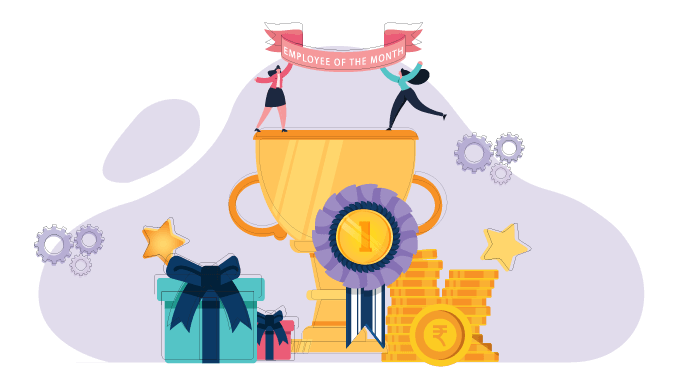
Recognition is not a scarce resource. You can't use it up or run out of it.
~Susan M. Heathfield
By now, we can all agree that having an employee reward and recognition program makes engaging employees a lot easier.
So how do you go about building one?
It’s not too complicated if you have the following cheatsheet to build a rewards and recognition program that’ll maximize your organization's employee engagement levels.
1. Clarify your Vision
Before you start implementing a rewards and recognition program, you must be clear about what it entails.
Goals
Be sure to document your goals, objectives, expectations, and the intended result from the rewards and recognition program.
Identify the purpose of implementing the program. Is it to increase the level of employee engagement? Increase sales? Or to build a better company culture?
Benefits
Research about the possible benefits that a rewards and recognition program can bring to your organization.
All in all, gather a better understanding of how such a program can be aligned to meet your company’s goals and needs.
Cost
To ensure that there is no overspending, misplaced finances, or negative ROI along the way, it’s essential to have a cost estimation (including hidden costs) in place. Even more efficient is to do an intelligent budget allocation.
2. Build A Committee
For a rewards and recognition program to be efficiently implemented, the first step any organization should take is to form a committee.
A well-chosen committee benefits you in implementing the program effectively by communicating and reinforcing the R&R program’s belief to the entire workforce.
3. Define Clear Characteristics
Another important step before implementing any rewards and recognition platform is to understand the characteristics that should be the building block of the program:
Timely
It is considered a good practice to recognize someone as soon as the deed is done.
Create a culture of appreciation where every small and big performance standard set by someone is appreciated on the spot.
Frequent
Recognition should be a real-time process where no great work should go unappreciated.
It’s not about appreciating only the more significant milestones but about the appreciation of the tinier.
Specific
Recognition is more meaningful when specific accomplishments are celebrated. Being specific means that employees know that a certain amount or kind of performance is rewarded.
Value-Based
If your organization has a set of deep-rooted values, seek to incorporate the same in the rewards and recognition that you give out to your employees.
4. Define Clear Criteria
The key to meaningful recognition is to set the criteria for getting rewarded and appreciated by their peers and supervisors.
The idea behind creating criteria for recognition is to reward and encourage behaviors that you want to see flourish in your organization.
Review a series of criteria such as below to find out what suits the best for your organization:
What type of behaviors should be rewarded?
Decide what type of behaviors and work should be rewarded and appreciated based on the values that you are seeking to cultivate in your organization.
How to reward said behaviors?
It’s important to set criteria for how recognition should occur and what kind of rewards to be offered.
How often should employees be appreciated?
Amplify the effect of recognition given by making it more frequent and prompt.
5. Ensure Successful Implementation
Once you get the prerequisites out of the way, it’s time to implement the rewards and recognition program successfully.
Get the employees onboard
Make employees aware of the program, how to use it, the benefits, and encourage them to utilize it daily.
Moreover, make the program easy to use and understand so that every employee in your company can use it without any hassle.
Advocated by senior management
The supervisors, managers, and senior management should promote the program’s use and subsequently use it frequently.
That will help to portray a scene where employees take the R&R program seriously because their manager is placing value on it.
Align with company values
If you want to see successful implementation and positive results, then the most reliable way to do so is to align the program with the company culture.
6. Measure and Revisit
Your job doesn't end even after the rewards and recognition program has been successfully implemented and running.
Measurement
Organizations of today employ many methods to measure the after-effects of implementing an R&R program, out of which the most popular seems to be an employee survey program.
An employee survey tool is a relatively cost-effective and easy way to gather data from employees themselves about whether their engagement level has improved or not.
Significantly, pulse survey tools, such as Vantage Pulse, help you gather instant, fast, and real-time employee feedback, which will help identify the areas of strengths and improvement.
Revisit
With changing business demands and employee needs, it seems unfeasible that your rewards and recognition should stay the same.
On the contrary, it must continuously evolve and adapt accordingly to meet the ever-developing workforce’s requirements.
That’s why it’s vital that you continuously revisit the improvement areas to tailor it to the present-day needs.
Chapter 9
Rewards And Gifting Ideas

People work for money but go the extra mile for recognition, praise and rewards.
~Dale Carnegie
By now, you must be interested in knowing the various ways through which you can reward your employees. Here are some of our favorite ways:
1. Reward Points
Developing a point-based reward system provides a perfect platform for ongoing recognition. Employees are awarded points for every time they go above and beyond.
After accumulating a certain amount, employees can redeem their points for gifts. You could offer a variety of rewards for the employees to select from.
2. Gift Cards
Gift cards are available for almost everything you can think of.
What makes gift cards unique and better than cash is that they ensure your employees have guilt-free spending.
Monetary rewards get to spend on something trivial, which in turn makes the reward seem insignificant. Gift cards, on the other hand, account for thoughtful spending, which validates the reward better.
3. Surprise Grab Bag
You can make the whole gift-giving fun by curating a few combinations of gift hampers for your employees.
The hamper can have items such as movie tickets, gift vouchers, office essentials, phone covers, water bottles, etc.
Recommended Article: 13 Ways To Reinvent Your Company SWAG
4. Personalized Rewards
Gone are the days when you can apply a “one-size fits all” approach while rewarding your employees.
A tailor-made reward naturally creates a lasting impact on the mind of the receiver. When you go out of your way to add a personal touch to your reward, it ascertains a connection between the receiver and the giver.
5. Online Classes
Offering sponsored online classes on the topic/course of their choice to employees make for a great corporate reward option.
It facilitates personal and professional employee development, which will account for even better performance in the long run.
6. Uber Ride Credit
If you live in a city with ride-sharing, your employees most likely use it. They might even use it to get to work every day. Give them credit with the service they use the most to cover a month or two of trips.
7. On The Go Electronics
Electronics such as smartwatches, fitness trackers, portable Bluetooth speakers, headphones, phone adapters, power banks are favorite gift items among millennials and GenZers. The receiver will always appreciate a good quality electronics product.
8. The Best Parking Spot
Like your office, a parking spot that's close to the office or in the shade is a high level of privilege to those who bring their cars to the office. Give it up to your winner for a week as a daily reminder of how you value them.
9. Free Event Tickets
It's pretty much impossible to find someone who doesn't love either a certain kind of music or a specific sports team. Concert tickets are another great, custom-tailored reward you can offer to employees who have done a great job.
10. Vacation Benefits
Allowing your star employees to take time off gives them a well-needed rest and signals that you care about your employees’ well-being, resulting in a happier and productive work culture.
Recommended Article: Ultimate List Of Corporate Diwali Gifting Ideas
Chapter 10
Employee Recognition Ideas

The deepest principle in human nature is the craving to be appreciated.
~William James
Here are a few recognition ideas that are sure to make your employees feel all warm and happy inside. Have a look:
1. Gift of Gratitude
One of the most obvious yet incredible ways of recognizing employees is by showing gratitude to your employees.
Everybody craves for some appreciation and the impact of a verbal or handwritten “thank you” is unparalleled to any other form. So, make sure you don’t miss out on saying thank you to your deserving employees.
2. Anniversaries and Birthdays
Sending a generic email on the birthdays of your employees (although it is better than nothing) is not enough.
You've got to make them feel special on their special day. And the good old “Happy Birthday” song and a cake never fail to make your employees feel recognized.
Also, celebrate personal milestones like wedding anniversaries, work anniversaries, promotion celebrations, etc.
Recommended Article: 7 Terrific Office Birthday Celebration Ideas
3. Handwritten Note
Handwritten notes are an incredibly personalized form of recognition that any employee would love to receive. Not only does it show employees that you care and appreciate the hard work they’re doing, but it also builds a sense of loyalty from their side.
You can also encourage sharing handwritten notes as a form of peer-to-peer recognition during special occasions like- anniversaries, Christmas, Valentine’s Day, and others.
Recommended Article: 50 Best Words of Appreciation for Employees
4. Time off
When an employee goes above and beyond to get a particular piece of work done, you can give them an extra day or two off or a short paid-holiday just to show them that they truly deserve a pat on the back.
Doing so will boost their motivation and, at the same time, present a caring image of the company.
5. Wall Of Fame
Having a wall of fame in the office where the achievements or accomplishments will be displayed for the entire staff to see will be a perfect topping on the employee recognition cake. It will make the appreciation even more notable and valuable.
6. Celebrate Work Anniversaries
Celebrating employee milestones like their work anniversaries is a great way to acknowledge your employees.
Surprising them with an anniversary present during a company meeting or throwing them a small party at the workplace will, sure enough, do the job here. It will incorporate a sense of importance in them about how their work has impacted business growth.
7. Trophies
It might be a traditional recognition idea, but trophies, placards, and awards make for a great physical reminder of the employee’s recognition.
Any person would be honored to show off these souvenirs in their homes and office desks. Especially for occasions like work anniversaries, a glass plated award remains an effective way to laud and celebrate the employee for their years of service.
8. Performance-based Recognition
Performance-based awards have a charm on their own, and they have continuously proved to be a compelling source of recognition for a long time. Such a time-honored practice that drives motivation must not be ignored.
9. Acknowledge Non-Work Achievements
You must always make it a point to acknowledge employees' outside achievements as well.
It ensures everyone in the workplace is aware of each other’s capabilities. When fellow peers show support for each other's endeavors, it promotes a strong working relationship between them.
10. Printable Certificates
When recognizing employees, ensure that there is a printable certificate to go along with the said appreciation. It helps establish the authenticity of the recognition and is an excellent addition to be included in the employee’s work achievements.
Recommended Article: 50 Rewards and Recognition Ideas to Boost Employee Recognition
Summary
The right forms of recognition and rewards at the right time can have unparalleled positive effects in terms of increased employee engagement, productivity, morale, and performance.
Moreover, employees become more focused, oriented, and invested in the company goals and objectives. Isn’t that an incredibly win-win situation?





















